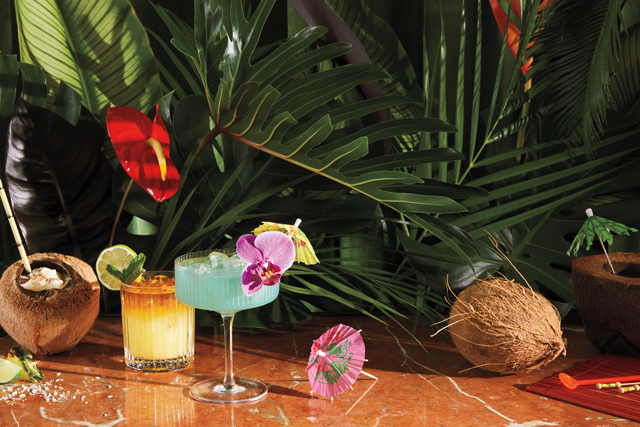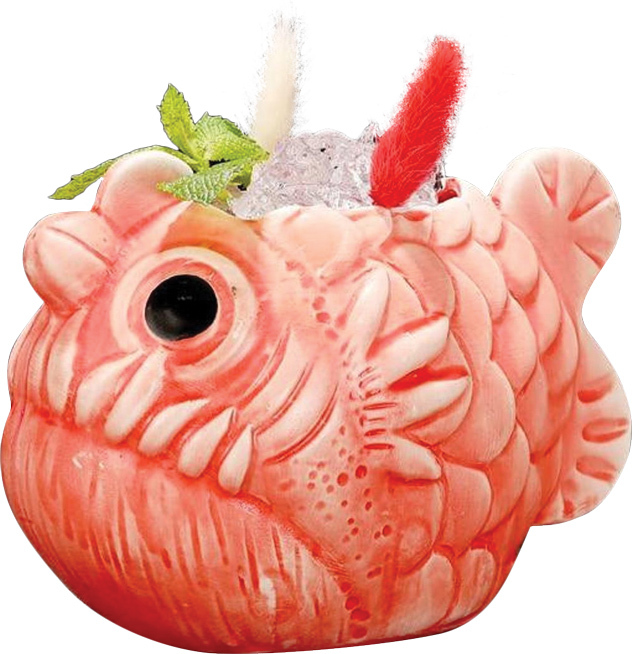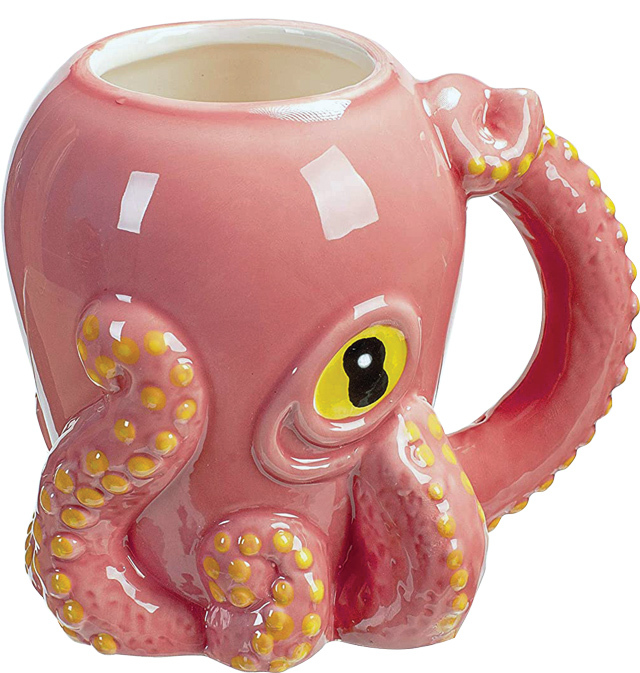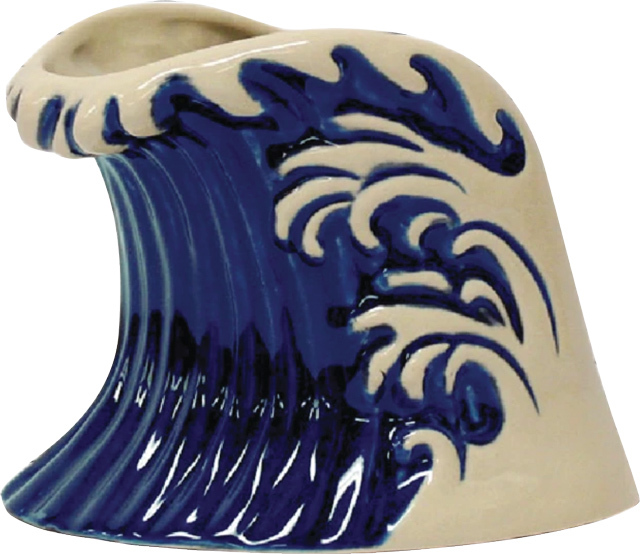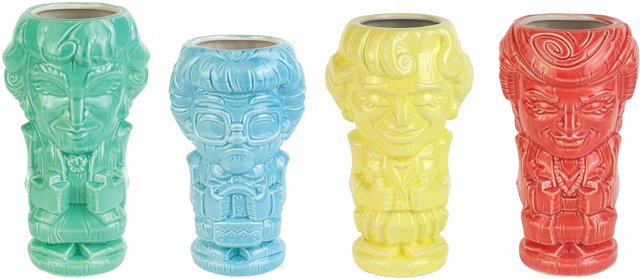Girls Just Wanna Have Rum
Want to enjoy the kitschy glamour and delicious refreshment of Tiki cocktail culture without the gnarly colonial aftertaste? Women are leading the way, creating a tropical drink revival for a more enlightened generation
The room glows amber, its walls papered with gold-leaf palm fronds. Bird calls emanate from the speakers, buoyed by the soft lilt of vibraphone. Revelers sip orchid-laden elixirs while topless, brown-skinned women, painted on backgrounds of black velvet, smile demurely from their frames. The menu boasts an array of potent cocktails—“Zombie,” “Mai Tai,” “Suffering Bastard”—as well as a “Pu Pu Platter”: an assortment of fried shrimp, spareribs, pot stickers, chicken wings, egg rolls, and wonton chips. A wooden figure, its face carved into an exaggerated grimace, watches the scene from a corner. Welcome to the all-American Tiki bar.
The Tiki trend can be traced back to 1933, when a well-traveled bootlegger named Ernest Raymond Beaumont Gantt (aka Donn Beach) opened his eponymous bar, Don the Beachcomber, just off Hollywood Boulevard. The former tailor shop, which he decorated with old nets and other seaside ephemera scavenged from Los Angeles’ beaches, soon became a hangout for Hollywood’s elite. With the help of a quartet of Filipino bartenders, known as the “Four Boys,” Beach began alchemizing multi-layered, spice-heavy drinks and eventually invented a whole new genre of cocktail. Both the concoctions and atmosphere were enticing for Americans, most of whom, in the 1930s, had never visited the Pacific Islands and therefore had no idea that what was being presented to them wasn’t genuine, but entirely made up.
The siren call of Tiki only became more seductive in the post-World War II era of the 1950s. Nostalgic for their days stationed in the South Pacific, American GIs flocked to these bars once they returned to the States, and civilians followed. Verdant foliage, waterfalls, torches, and carved Tiki heads dominated the era’s decor. Drinks were given exotic-sounding Hawaiian names, mugs were whittled into the shape of gods revered by indigenous people throughout the South Pacific islands, and patrons were served Chinese food—because, in mid-century America, most customers were too naive to identify it as such. Sven Kirsten, author of The Book of Tiki: The Cult of Polynesian Pop in Fifties America, later deemed the fad “Polynesian pop.”
At the center of the craze, Kirsten writes, were hypersexualized images of young, nude, native girls, “the Eve in a Polynesian Garden of Eden, [they] became the first and foremost icon[s] of Polynesian pop, embodying the promise of unconditional love.” Truly, from its inception, the aesthetics of Tiki relied on a blend of sexism and racism. Before it burned down in 1969, Ren Clark’s Polynesian Village in Fort Worth, TX, offered drinks called “The Virgin’s Lament” and “The Black Woman.” While at the 600 Club in Miami, Kirsten writes, revelers were given matchbooks embossed with bare-breasted hula girls, the surface raised to give “the user the tactile sensation of actual nubile mounds under their fingertips.”
Just as egregious as its portrayal of women was the way the trend co-opted the Tiki itself. The word “Tiki” signifies a sacred carving of a God-like ancestor to Pasifika peoples—the indigenous communities of the Pacific Islands, including Melanesia, Micronesia, and Polynesia. In Rarotonga, one of the Cook Islands, Tiki is said to guard the gates of paradise, accepting porcine bribes from the dead. Those who live in the neighboring island of Mangaia believe that Tiki was a woman, and the first person to experience death. The details vary, but the premise is the same: the Tiki is a sacred symbol that has been unapologetically used by white Americans as a kitschy decorative motif for over 70 years.
One of the most ironic aspects of the Tiki vogue is that while the islands of the South Pacific are now idolized by Westerners as utopian, many aspects of their indigenous cultures were originally suppressed or erased by European colonizers. The Hawaiian language, for instance, was banned from schools and the government after Hawaii was annexed by the United States in 1896. Yet today, Tiki bars are quick to implement Hawaiian words and phrases in order to sound more “exotic.” Similar examples abound when it comes to the languages, dances, art, and religions indigenous to the rest of the islands of Oceania. Given its thorny past, it seems that it’s high time to revamp the Tiki phenomenon—and a small group of women are leading the way, examining whether there’s anything from the fad worth saving.
One such woman is Mariah Kunkel, a Chamoru (indigenous people of the Mariana Islands) and Black Los Angeles-based spirits marketer. Kunkel spent quarantine co-founding Pasifika Project, a group that fosters grassroots activism and provides support for people with Oceanic heritage working in the hospitality and spirits industries. In the future, Kunkel hopes to host in-person events, providing a space for Pasifika people to network, connect, share stories and food, and begin to reframe cocktail culture. “For Chamorus,” she says, “there’s a sense that our indigenous culture is either old or lost or doesn’t exist anymore.”
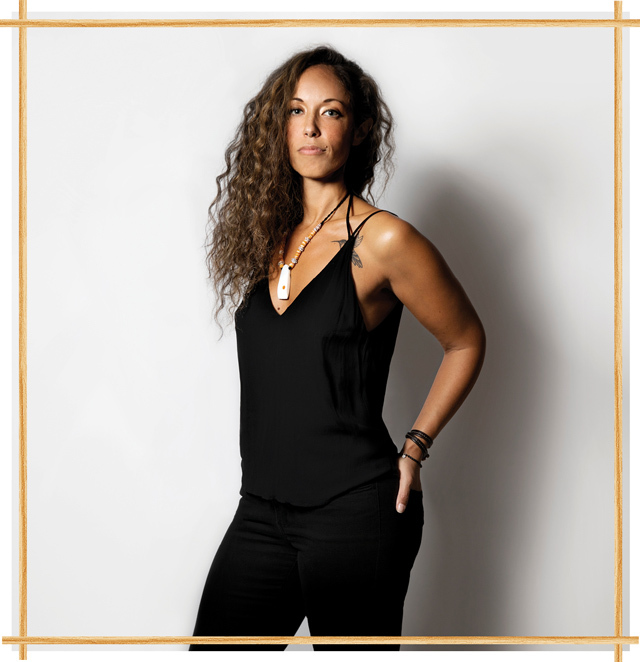 Mariah Kunkel // Photo: Amelia Joyce Tubb
Mariah Kunkel // Photo: Amelia Joyce Tubb
Growing up in southern California, Kunkel first began patronizing Tiki bars with her dad. “For my father, I think that there was a sense of him knowing that he was Chamoru and knowing that he was Pacific Islander, but having that culture completely oppressed. And in the absence of that, [he sought out] Hawaiian culture through an American lens—through Tiki bars. [It’s] sort of weird being fed your culture back to you through this lens of white colonialism. It’s hard when you have no representation, and the only thing that’s representing you is something that’s so fucked up.”
Kunkel doesn’t remember discussing the troublesome nature of Tiki bars with her father. But after visiting the same spots as a brand representative, she began having these conversations with fellow brand rep Samuel Jimenez, with whom she would later co-found Pasifika Project. Now, Kunkel’s mission is “not to slash and burn Tiki” but to encourage a transition to “tropical,” which she envisions as letting go of Hawaiian names, Pasifika carvings, hypersexualized images of Pasifika women, the use of the word “Tiki,” and problematic iconography. This includes using the word “Pasifika” instead of Hawaiian or Polynesian—since the cultures that these bars borrow from are located all over the Pacific—and ditching the popular old-school Tiki vessel, the Bali Hai headhunter mug, which is “literally a brown man with a bone through his nose and you drink out of his skull. Like, is that my dad?” asks Kunkel. “Our women are always sexualized and our men are always made into savages.”
Hula girl imagery hits close to home for Kunkel, as well. “We have pictures of my grandmother wearing a plastic grass skirt, dancing,” says Kunkel. “She was the oldest daughter of eight during World War II. She had to work. And this was how she could work.” It didn’t matter to the sailors watching that Kunkel’s grandmother was Chamoru, a people whose traditional dances had been suppressed by colonizers, and that they were paying her to enact a custom borrowed from another Oceanic culture. “When I see these black velvet naked lady paintings [often found in Tiki bars], I see her first,” says Kunkel of her grandmother, “and then I see myself and then I see my nieces.”
“There are probably ways that some bars could engage with and promote Pasifika culture in a positive way,” Kunkel concedes. “I would love to see the support for this party theme extend to those actual cultures, because Pasifika existence is definitely in danger due to a variety of factors. But there needs to be a reckoning with and an honest assessment of the colonialist tropes that are embedded in many of these bars.”
Chockie Tom, a bartender and brand ambassador of Indigenous Pomo [Northern Californian] and Walker River Paiute [Central Nevadan] descent, is also an advocate for a shift from Tiki to “thoughtful tropical.” She defined the latter in a March 2021 bar education class for Portland Cocktail Week as “an approach to immersive and experiential bar concepts that combines cultural exchange and empowerment with non-harmful escapist ideals.” She maintains that it’s possible to enjoy a tropical bar experience without relying on dehumanizing imagery and caricatures of people from Pasifika cultures. “If I’m escaping to paradise,” Tom says in the video, “I don’t want it to be at the expense of somebody else—particularly if it’s somebody…whose whole world was turned upside down in order to create a paradise for outsiders.”
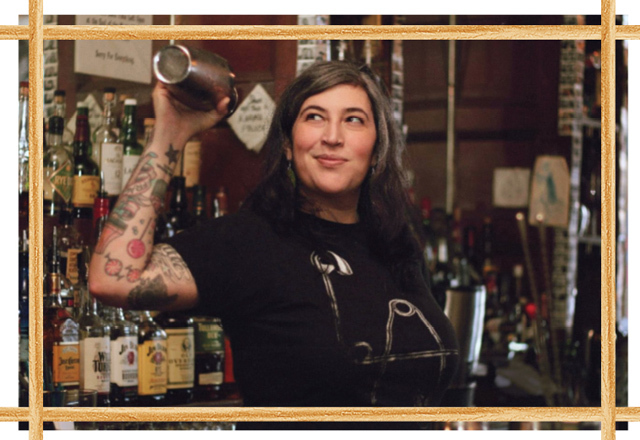 Chockie Tom
Chockie Tom
Since July 2019, Tom has been throwing metal-themed, non-appropriative, tropical pop-up parties, in order to provide an escapist alternative to the typical Tiki bar encounter. Her events were originally hosted by Paradise Lounge in Queens, with each evening revolving around a different motif, such as Captain Cook’s Death Day. Tom would “fundrage” by selling signature cocktails—including “Hand of Doom” and “Useless Anthropology Degree”—with proceeds benefiting folks who have been disenfranchised by colonization.
Since Covid struck, Tom’s parties have gone online, with guest bartenders mixing drinks for a virtual audience. Without participants buying cocktails, the “fundraging” is also on hold. But that doesn’t mean that Tom’s mission of bringing “thoughtful tropical” to the masses is slowing down. “Some people [say], ‘Well, it’s only authentic Tiki if it looks like this,’” says Tom. “But what’s authentic about something that’s made up?”
When it comes to re-tooling the scene, mixologist Jane Danger is also game. As beverage director of the now-defunct, Pasifika-inspired, East Village bar Mother of Pearl, Danger remembers trying to avoid using appropriative décor and terminology. She also yanked some of the more traditional drinks and replaced them with original creations, like Taste the Rainbow. The fruit-heavy cocktail, which arrived crowned with a ring of flaming Skittles, may have been a little off brand for Tiki, but it was a hit. “Rum-soaked, hot Skittles?” says Danger. “Not a bad thing.”
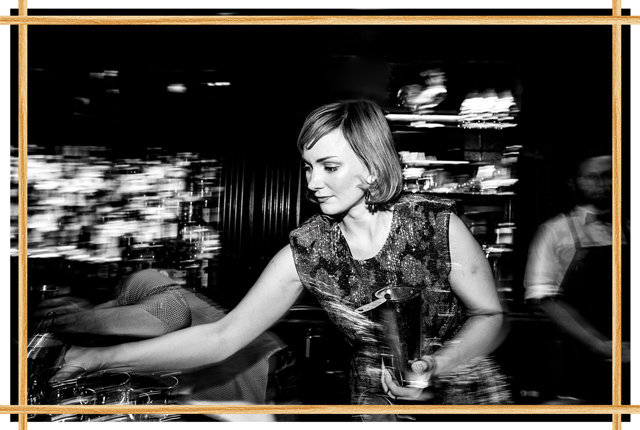 Jane Danger // Photo: Ben Ko
Jane Danger // Photo: Ben Ko
Like Tom, Danger is intrigued by tropical bar culture and sees it as a form of escapism that can go in new, niche directions. “Tiki doesn’t need to be the things they tell you it needs to be,” she says. “Tiki is punk. It’s a mentality.” Danger’s own infatuation with the Tumblr aesthetic known as “seapunk” also inspired new furnishings. Soon, Mother of Pearl’s historic storefront was not so much island-inspired as sea-adjacent: decked out with aquatic animals and leafy flora and lit an oceanic blue.
While tropical bars have always sought to evoke a maritime vibe, their idolization of the ocean is surprising, considering how much garbage the hospitality industry generates. “Tiki is probably the guiltiest of all the different types of bars when it comes to waste,” says Claire Sprouse, a Filipino-American bartender and owner of the eco-conscious Brooklyn bar Hunky Dory. She adds that Tiki drink decorations—plastic swizzle sticks, mini parasols, flowers flown in from afar, and non-edible garnishes—make the style especially unsustainable.
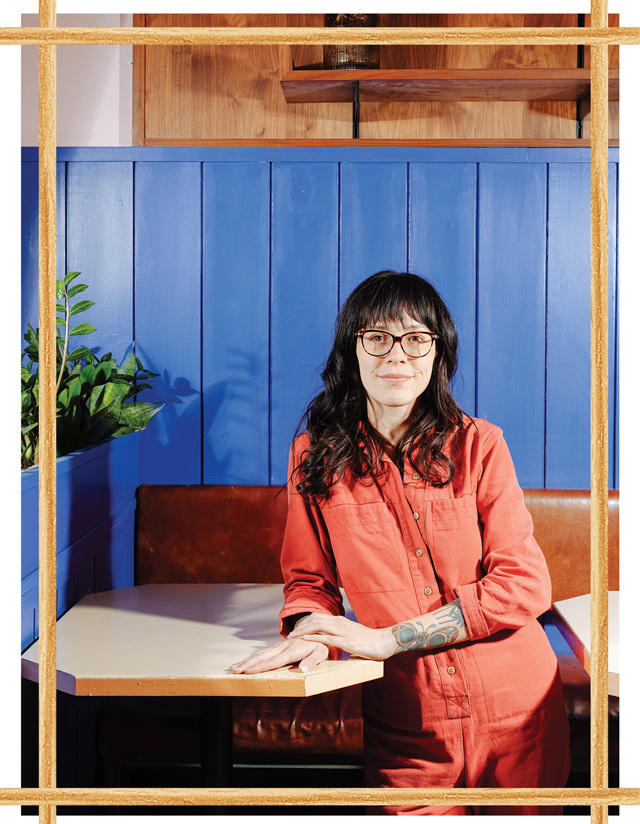 Claire Sprouse // Photo: Breanne Furlong
Claire Sprouse // Photo: Breanne Furlong
“When we talk about escapism in Tiki, we have to think about the places that we’re ‘escaping’ to,” Sprouse said in her 2020 talk, “All Hands On Deck—Why Tiki Must Get Green,” for the YouTube channel Tiki by the Sea. She further pointed out that the cultures predicted to suffer the most from climate change are the very ones that the Tiki movement replicates, adding, “Where do the people in these places get to escape to as waters rise and land is compromised?”
One tropical brand that’s reworking its relationship with the environment is the self-described “anti-waste punk pop-up” Trash Tiki. They adhere to the motto, “Drink like you give a fuck,” by crafting their cocktails from ingredients that would otherwise be wasted (i.e. pulps, husks, and grounds). In September 2020, they also nixed half of their moniker. “We see now that ‘Tiki’ has never been given the chance to be defined by those from the culture(s) it represents,” the group wrote in a blog post announcing that it would be known simply as “Trash” going forward.
When it comes to rebranding, Trash is in good company. The annual New Jersey conference Tiki by the Sea recently dropped the Tiki statuette from its logo and Tom, whose parties have thus far been presented using the moniker “Doom Tiki,” plans to follow suit. “‘Thoughtful tropical’ is the next evolution of what Tiki needs to be,” says Tom.
Still, it’s not all banana liqueur and heavy metal when you’re trying to change a long-standing American tradition. “I have received threats of violence and rape and things like that because of the work I’m doing,” Tom says.
Kunkel also laments the state of her inbox. “I don’t want to keep getting emails [that say] ‘You’re an idiot,’” she says. “It would be nice to be able to build a way forward together.”
Over the last few years, there has been a marked increase in awareness around the need to remedy what’s wrong in Tiki culture. Kunkel, Tom, and Sprouse have all given talks about the ways they envision Tiki changing, and bars have increasingly begun to veer away from “Tiki” and towards “tropical.” “We’re just at a time of transformation, historically,” says Tom. “Everything’s moving forward. You can choose to fight it, but at some point, you’re going to get left behind.” This new iteration of Tiki might not be what everyone wants, but it’s setting sail, and all are invited aboard. “Come for the cocktails,” says Kunkel, “stay for the decolonization.”
Upgrade Your Vessel
When choosing a mug, think “tropical” not “Tiki.” From sea creatures to Golden Girls, these picks are sure to pop:
Ceramic Scaled Fish Hawaii Tiki Cocktail Mug, $36
Handmade Tiki Mug Banana, $24.99
Pink Octopus Ceramic Coffee Mug, $13.46
Wave Mug, $60
Geeki Tikis The Golden Girls Cast Mugs, $93.56

Let Your Cup Runneth Over With Ethically-Made, Sustainably-Sourced Spirits
Now that you’ve found your perfect mug, it’s time to fill it. Claire Sprouse recommends these brands that are also doing good in the world:
Vodka from Good Vodka
Organic Cachaça from Novo Fogo
Tequila from Siembra Azul
Mezcal from Clase Azul
Rum from Don Q
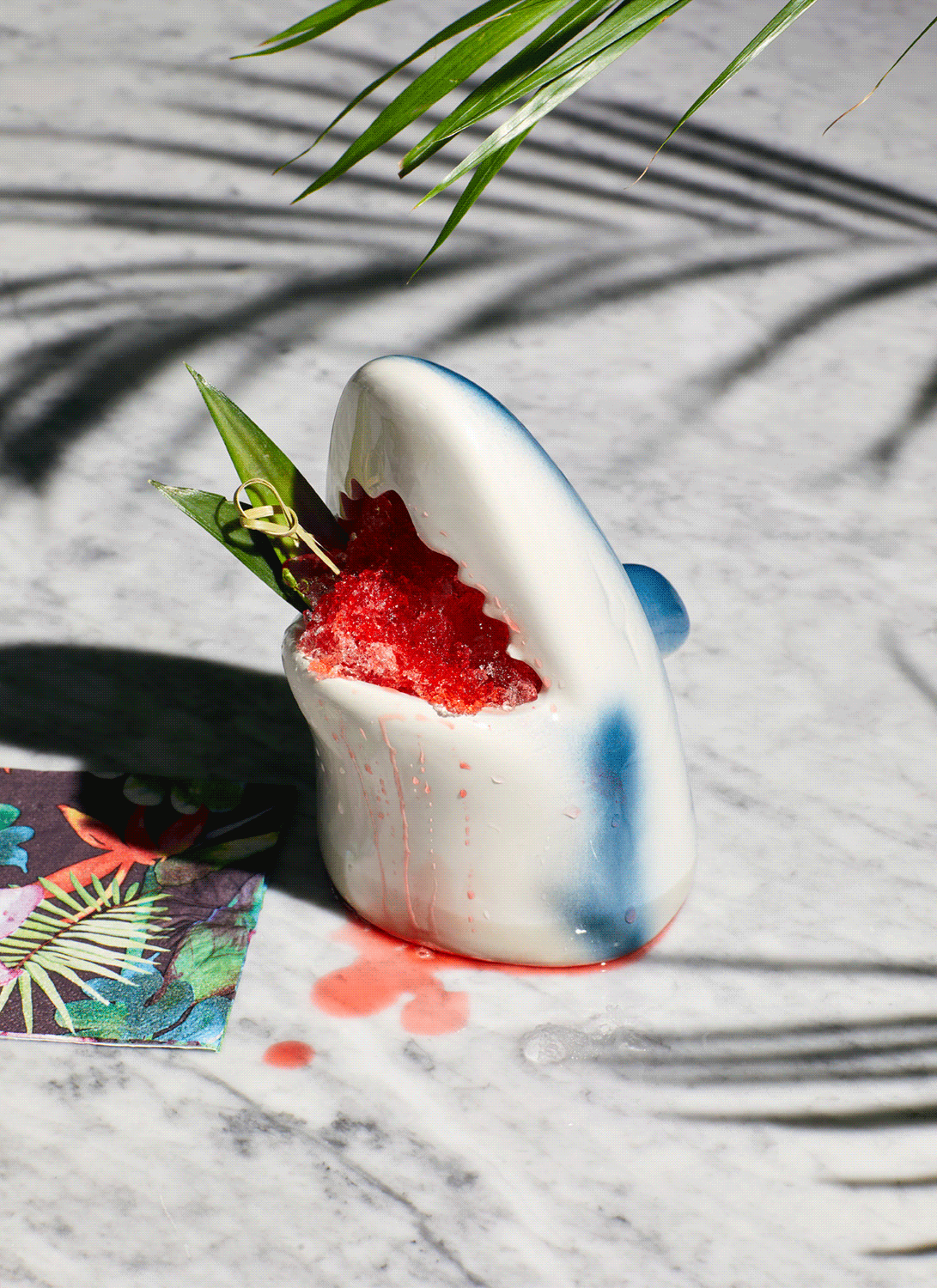 Photo: Winnie Au // Styled by: Vanessa Vazquez
Photo: Winnie Au // Styled by: Vanessa Vazquez
Jane Danger’s Shark Eye
To make:
In a cocktail shaker, combine all of the ingredients except the ice and garnishes. Shake well and pour into a chilled shark mug or rocks glass filled with crushed ice. Garnish with the pineapple leaves and Peychaud’s bitters.
You will need:
- 1 ½ ounce bourbon, preferably Elijah Craig 12-year
- ¾ ounce passion fruit syrup (available at specialty stores and from kalustyans.com)
- ¾ ounce fresh lemon juice
- ½ ounce bonded rye whiskey
- ¼ ounce Luxardo maraschino liqueur
- 1/8 ounce curaçao
- 2 dashes of Tiki bitters
- Crushed ice
- Small pineapple leaves (optional) and 3 dashes of Peychaud’s bitters, for garnish
Earth-Friendly Garnishes
Looking to make your own waste-free tropical drinks? Claire Sprouse suggests visiting your local community garden and digging around.
- Nasturtiums are widely available and completely edible, from blossom to stem! “Their stems have a very different flavor; they’re very peppery,” says Sprouse.
- Chocolate mint and sunflower petals are aesthetically pleasing drink toppers that also taste great.
- Looking to add some punch to your punch? Dry out a hibiscus flower, grind the petals into a powder with a mortar and pestle, and sprinkle it on your cocktail to give it a floral note and a pretty pink glow.
- Repurposed citrus peels also make versatile garnishes. Sprinkle some zest on your drink, or if you have a dehydrator, dry out citrus rinds and top your cocktail with a curl!
- From bamboo to glass to metal, reusable straws are a must when decking out your drink.
By Luna Adler
Top photo and shark gif by Winnie Au / Styled by Vanessa Vazquez
This article originally appeared in the Summer 2021 print edition of BUST Magazine. Subscribe today!
More from BUST
The Founder Of Veggie Mijas Is On A Mission To Decolonize The Way We Eat
Julia Turshen—Rad Cookbook Author And Activist—Reveals Her Gourmet Pantry Staples
How To Make Your Own Cannabis Tincture

